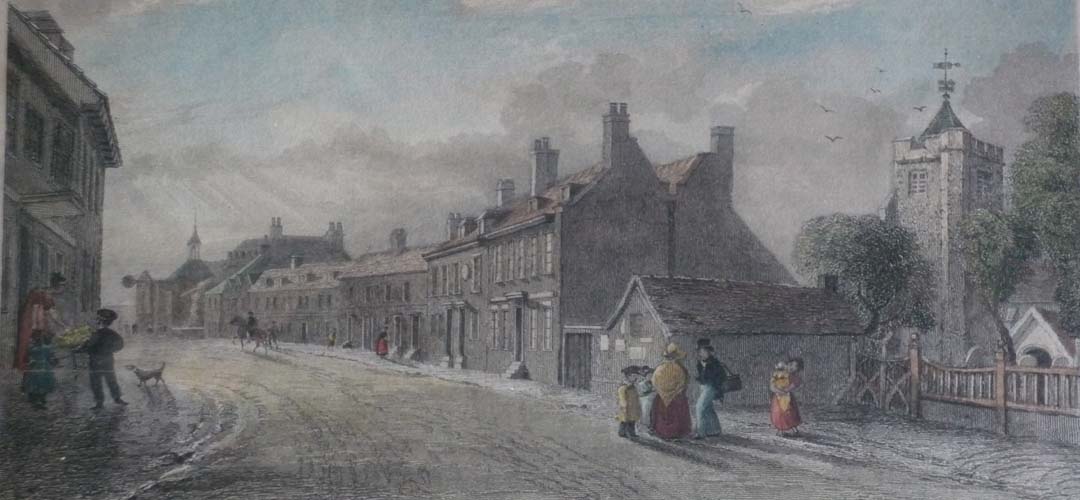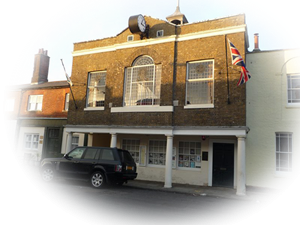
The suggested starting place for this tour is the Guildhall, it being perhaps the central point in the Conservation Area, and for centuries the meeting place of the town. A small market was once held beneath and behind the Guildhall, but the practice seems to have declined gently through the years, no-one really knowing when it ceased to be held.
The Guildhall, built in 1794, replaces an earlier structure of the old Court House, and is a fine building indeed. Externally it is rather quaint with its colonnaded frontage, and is very impressive; while internally, at first floor level, is perhaps the most beautiful room in all Sheppey. In recent years it was decorated and restored to its former elegance and continues to be refurbished to maintain its splendour. It still contains the furnishings and trimmings of the Council Chamber it once was, and although the town’s administrative offices are now based mainly in Sittingbourne, the building continues as a public meeting place. It is now used regularly by the Queenborough Town Council, established in 1983, and also by the Queenborough Society since its formation in the early 1970’s. It also attracts numerous visitors.
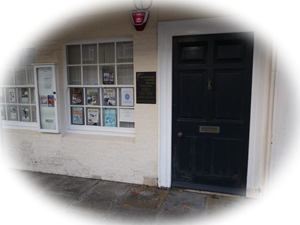
The lower floor now houses the Queenborough Museum which contains many items of local interest and information about HMS Wildfire – the minesweeping base during the second world war.
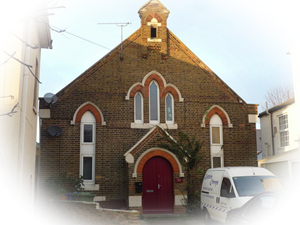
Continuing from the Guildhall up the High Street, we pass the old Wesleyan Chapel on the left.
For many years after falling into disuse, it became very derelict, but recently a local builder has resorted It to its original exterior look and converting the interior to modern residential use.
We then pass an attractive row of terraced houses on our way to Nos 72, 74 and 76, 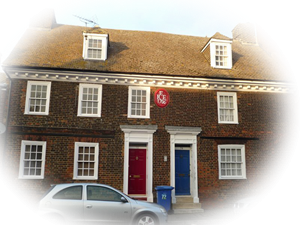 a very picturesque group of nautical and rather stately looking buildings. A plaque above the doorways of Nos 72 and 74 (which were restored in 1982) dates them as being built in 1706, a prominent period in Britain’s naval history, and one wonders what famous seamen might have lived there.
a very picturesque group of nautical and rather stately looking buildings. A plaque above the doorways of Nos 72 and 74 (which were restored in 1982) dates them as being built in 1706, a prominent period in Britain’s naval history, and one wonders what famous seamen might have lived there.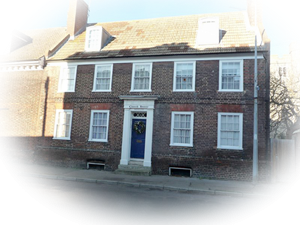
Indeed, No 76, Church House, built in 1703 is reputed to be the house where Lady Hamilton stayed, and that it was visited by Nelson on his numerous trips to Queenborough.
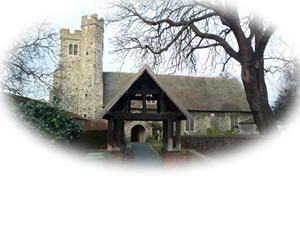 He certainly stayed somewhere in the town for there are records of his taking communion at the church.
He certainly stayed somewhere in the town for there are records of his taking communion at the church.
Queenborough church is a small, though interesting, building, the nave dating from 1367. It was built by Edward III as part of his plan for the town. 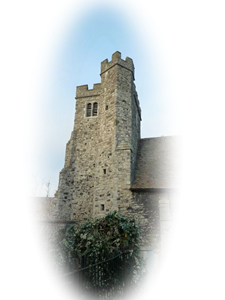 The tower, a splendid specimen, is believed to date from the Norman period. It is an important land mark with a fine view from the top. It has six bells, the earliest dated 1667.
The tower, a splendid specimen, is believed to date from the Norman period. It is an important land mark with a fine view from the top. It has six bells, the earliest dated 1667.
The church stands on the site of a far earlier building, a chapel, which was attached to Minster Abbey. It did not achieve parish church status until after the reformation in 1557. Queenborough church has been used over the years for many purposes other than religious, the most curious perhaps being its possible use as a boat house. Happily today it has fully regained its rightful dignity and purpose.The font dates from 1610 and depicts, in relief work around its sides, a representation of Queenborough castle with cannons, which at that time was still standing, though in how ruinous a condition we do not know.
A surprising, and perhaps unique, feature of the church is its painted ceiling, still very beautiful even though it has been damaged by fire. The artist is unknown, but it is believed to have painted by a Dutchman at the end of the 17th century. The decoration represents the firmament and is probably unique in an English church.
The key for the church may be obtained from the Vicarage, North Road. A separate guide is available.
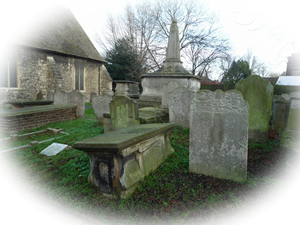 The churchyard, in addition to housing many interesting gravestones,
The churchyard, in addition to housing many interesting gravestones,
provides a welcome splash of colour to the High Street,
with its green trees and shrubs.
There are numerous graves sited on top of each other.
Their careful study is rewarding.
Continuing on up the High Street, we next arrive at Fig Tree House.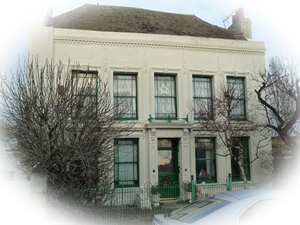
Internally this house has remained relatively unchanged since Victorian times. It dates from the 18th century, and with the neatly painted white modern house next door (site of an early cinema) it forms an attractive little group. It is thought that stones taken from the Castle may have been used to build the garden wall.
A little further on we come to another attractive 18th century group,
The Old Vicarage and Mill House. 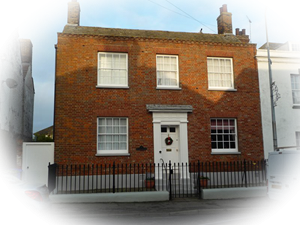
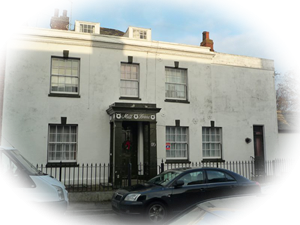 The Old Vicarage frontage has been rebuilt and restored to the original style and is now very pleasing to the eye and very much in keeping with a house of its period.
The Old Vicarage frontage has been rebuilt and restored to the original style and is now very pleasing to the eye and very much in keeping with a house of its period.
The care bestowed upon this house shows just what can be done to conserve the 18th century atmosphere, while Mill House shows how old buildings can easily adapt to new uses without detracting from their character. An extension built on to the side is used as a doctor’s surgery.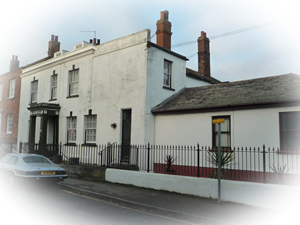
Stones taken from the Castle may also have been used here in the construction of the garden wall. Mill House takes its name from the one-time windmill that stood in the garden. Earlier it was a sturdy farm house.
There is an attractive group of modern houses at the top of the High Street, but now we cross North Road, bear round to the right and follow the road to the railway station.
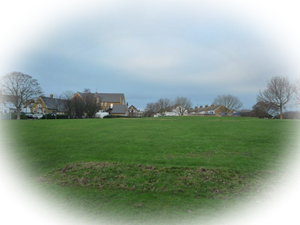 The seemingly insignificant grassy mound immediately to the left of the station building is the site of the castle. On top of the mound is a concrete platform capping two wells, one the original castle well, the other dug and used by the railway company for water to service stream locos.
The seemingly insignificant grassy mound immediately to the left of the station building is the site of the castle. On top of the mound is a concrete platform capping two wells, one the original castle well, the other dug and used by the railway company for water to service stream locos.
The railway station has been restored, its exterior retaining its former Victorian splendour. 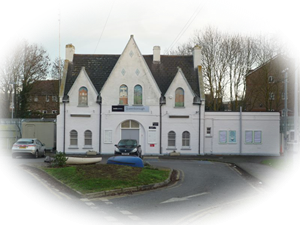 It continues to be preserved to meet up to date conditions without distraction from its Victorian appearance.
It continues to be preserved to meet up to date conditions without distraction from its Victorian appearance.
